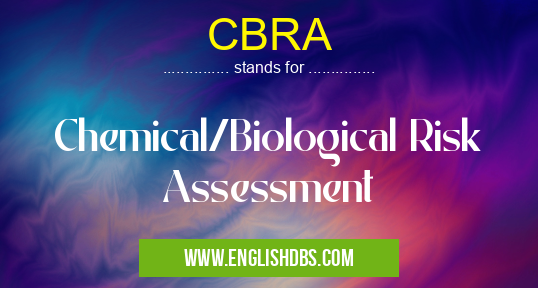What does CBRA mean in MILITARY
Chemical and biological risk assessment is a structured process to objectively evaluate potential risks associated with the use of hazardous chemicals or exposure to biological agents. It utilizes data on toxicity and other related parameters from both laboratory and field studies that are subjected to various health-risk assessments. The goal of CBRA is to identify any possible adverse health effects, determine the levels of acceptable risk associated with certain activities, and find ways to reduce those risks. The CBRA provides agencies, organizations, and individuals the necessary information to make informed decisions about chemical and biological exposure.

CBRA meaning in Military in Governmental
CBRA mostly used in an acronym Military in Category Governmental that means Chemical/Biological Risk Assessment
Shorthand: CBRA,
Full Form: Chemical/Biological Risk Assessment
For more information of "Chemical/Biological Risk Assessment", see the section below.
» Governmental » Military
Essential Questions and Answers on Chemical/Biological Risk Assessment in "GOVERNMENTAL»MILITARY"
What is Chemical/Biological Risk Assessment?
Chemical/Biological Risk Assessment (CBRA) is a structured process to objectively evaluate potential risks associated with the use of hazardous chemicals or exposure to biological agents. It uses data on toxicity and other related parameters from both laboratory and field studies that are subjected to various health-risk assessments in order to identify any possible adverse health effects, determine the levels of acceptable risk associated with certain activities, and find ways to reduce those risks.
What are some examples of hazardous chemicals?
Examples of hazardous chemicals can include chlorine gas, sulfur dioxide, benzene, asbestos fibers, polychlorinated biphenyls (PCBs), formaldehyde, trichloroethylene (TCE), polycyclic aromatic hydrocarbons (PAHs), heavy metals such as lead and mercury, polychlorinated dibenzo-p-dioxins (PCDDs) and polychlorinated dibenzofurans (PCDFs).
How can CBRA help agencies, organizations, or individuals make decisions about chemical & biological exposure?
CBRA provides agencies, organizations or individuals with important information concerning chemical & biological exposure that allows them make more informed decisions. By looking at a variety of sources such as laboratory studies & field tests results related parameters including toxicity it can provide an objective view that helps inform decision making processes regarding chemical & biological exposures.
Who is responsible for conducting a Chemical/Biological Risk Assessment?
Generally responsibility for conducting a CBRA falls upon professionals specialized in public health fields such occupational safety experts as well public health officers or environmental scientists. Depending on the situation organizations may need to employ 3rd party contractors specializing in conducting CBRAs.
What kind of information do I need before doing a Chemical/Biological Risk Assessment?
Before attempting any kind of risk assessment it is important you are familiar with relevant legislative regulations governing your particular industry as well knowledgeable about areas like human physiology & chemistry which relates specifically application type being assessed. Additionally also critical have up date information about materials processes used in specific case so you can accurately assess potential risks posed by substances being studied.
Final Words:
The goal of CBRA is to help ensure people remain safe when dealing with potentially hazardous chemicals or exposure to biological agents by providing necessary information required for decision makers when engaging in activities involving these types of hazards. By going through this process we can get one step closer towards improving safety standards for all involved.
CBRA also stands for: |
|
| All stands for CBRA |
